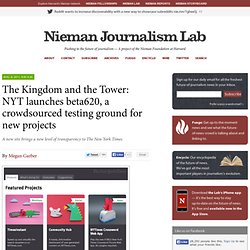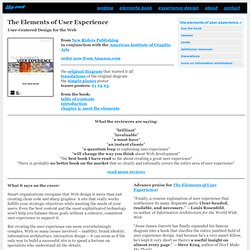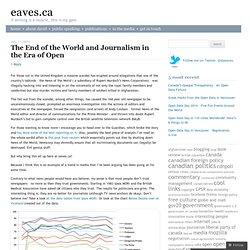

The Kingdom and the Tower: NYT launches beta620, a crowdsourced testing ground for new projects. Gay Talese described The New York Times as, variously, a “fact factory,” “a cathedral of quiet dignity,” a “daily miracle,” and a “necessary proof of the world’s existence.”

At the same time, however — and understatedly, as if it were a fact so obvious it barely merited mention — he noted the paper’s “insular atmosphere.” Whatever the Times was, Talese suggested, it was so in part because, physically and figuratively, the paper sat sealed and slightly separate from the world whose stories it told. It’s been nearly half a century since the days of The Kingdom and the Power, and as the Times has sped from a daily to an hourly to a minute-by-minute miracle, the divides that have distinguished the paper from the people it serves have been steadily dissolving. The storytelling apparatus housed at 620 8th Avenue still has walls around it, definitely, but those walls are becoming increasingly transparent.
Centrality — tracking all the Times’ experiments in one place — is another goal. News21: Carnegie-Knight Initiative on the Future of Journalism Education. The Death of Journalism? (or journalism in the era of open) For those that missed them two of my favourite authors – Clay Shirky and Steven Johnson – posted brilliant pieces on the future of the news industry this week.

I’ve pulled some of the best lines from both so you can glimpse at why these to writers are models for me. These relevant paragraphs also reveal a further analysis, one I think both authors stop shy of but that both pieces hint at: the Death of Journalism. …in the long run, we’re going to look back at many facets of old media and realize that we were living in a desert disguised as a rain forest. Local news may be the best example of this. When someone demands to know how we are going to replace newspapers, they are really demanding to be told that we are not living through a revolution.
Hack, hacker - makes no difference - Chris L. Keller ... A “six degrees of separation” database, nwsmkr will combine a journalist’s curated notes with public contributions & social APIs to visualize connections and distinctions between public figures, providing a new storytelling method for news organizations.

I remember the shock of it all, when I learned the bar to coding a basic webpage wasn’t that high. Three years later, I’m seeing more and more that the bar to coding a really great webpage isn’t all that high either. It’s patience and time, and the willingness to work hard. It was about this time in 2008, I was handed the keys to production of our newspaper’s website.
To do it I was learning on the job: an anchor tag makes the internets go round-and-round, and view-source allowed me to discover something instantly. Suddenly I learn could how to make big fonts, select menus and form inputs, and I had found my minor pentatonic scale. But here’s the thing. Oh, and your work is only as good as your sources – or source code. Jesse James Garrett: The Elements of User Experience. What the reviewers are saying: "brilliant" "invaluable" "a must-have" "an instant classic" "a quantum leap in explaining user experience" "will change the way you think about Web development" "the best book I have read so far about creating a great user experience" "there is probably no better book on the market that so clearly and rationally covers the entire area of user experience" read more reviews What it says on the cover: Smart organizations recognize that Web design is more than just creating clean code and sharp graphics.

A Growing Inventory of Journalism Collaborations « Groundswell. News sharing, editorial collaborations, business partnerships – journalists and newsrooms are increasingly exploring new ways to collaborate. Some of these efforts are resulting in exciting new kinds of news, pushing stories beyond what could have been done by any one person, and producing more local news for communities. Others, however, are leading to further consolidation, newsroom layoffs and a notable decrease in the amount of local reporting in communities. In seeking a way to organize, evaluate and better understand these collaborations and their impact on local news and local communities, I have begun breaking them up into categories (so far these categories include: New Sharing, Public/Private Partnerships, Public and Noncommercial Media Collaborations, and University News Partnerships).
Obviously, there are other ways of organizing this, and many of these collaborations straddle multiple definitions. 1) Commercial News Sharing 2) Public/Private Partnerships Like this: Partnerships for news: Promise and pitfalls. July 12, 2011 Partnerships are a promising way to support community news and information. By joining forces to create, distribute and market content, news sites and local institutions, such as universities and legacy media, can better serve the information needs of their communities. But there’s a catch. Or two. Use our methods. DP0 (Design Project Zero) is a 90-minute (including debrief) fast-paced project though a full design cycle.

Students pair up to interview each other, create a point-of-view, ideate, and make a new solution that is “useful and meaningful” to their partner. Two versions of DP0 are “The Wallet Project” and “The Gift-Giving Project”. They have the similar format, only the topic is different. The original DP0 The Wallet Project was created for the d.school’s very first course in 2004 and the project starts with students looking at the content of their partner’s wallet or purse (and goes on to ask every student to design something for their partner). Another DP0 topic is The Gift-Giving Project where students are asked to redesign how their partner gives gifts. The End of the World and Journalism in the Era of Open. For those not in the United Kingdom a massive scandal has erupted around allegations that one of the country’s tabloids – the News of the World ( a subsidiary of Rupert Murdoch’s News Corporation) – was illegally hacking into and listening in on the voicemails of not only the royal family members and celebrities but also murder victims and family members of soldiers killed in Afghanistan.

The fall out from the scandal, among other things, has caused the 168 year old newspaper to be unceremoniously closed, prompted an enormous investigation into the actions of editors and executives at the newspaper, forced the resignation (and arrest) of Andy Coulson – former News of the World editor and director of communications for the Prime Minister – and thrown into doubt Rupert Murdoch’s bid to gain complete control over the British satellite television network BskyB.
But why bring this all up here at eaves.ca? Dispatch-from-ire-important-lessons-from-investigative-collaborations171.html... From the air-conditioned meeting rooms to the muggy poolside bar, everyone at this year’s Investigative Reporters and Editors conference was talking collaboration.

It seems that our once doggedly independent industry is beginning to embrace a lesson long forgotten from elementary school: how to play nicely with others. And that might be because there are few alternatives. With newsrooms across the country still reeling from the plummeting revenues of the last half-decade, many organizations have begun working together as a survival strategy — especially when it comes to the typically more costly and time-consuming endeavors of investigative reporting. IRE’s four-day convention, which took place June 9 – 12 in Orlando, featured a good number of sessions focused specifically on collaboration, and the C-word trickled into many other panels that were supposed to be about other topics (global crime and corruption, working with students, etc.). Yes, but How? Knight Mozilla News Technology Partnership.
We are OpenNews We're helping a global network of developers, journalists, makers, and hackers collaborate on innovative code and new ideas. We believe a community of peers working, learning, and solving problems together can create the tools journalism needs to thrive on the open web. Here's how: Fellowships Knight-Mozilla Fellows spend 10 months embedded in partner newsrooms. Data is Shaping the Future of Journalism - O'Reilly Media - O'Reilly Insights. Beyond Comment Threads.
Mixing it Up: Engaging News Partners « NathanielJames.org. It’s been an amazing launch week for the Knight-Mozilla News Technology Partnership (aka “MoJo”).

We saw hundreds of tweets every day, coverage by 15 news outlets and blogs (plus lots of re-posts), almost 200 sign-ups on our new community list serve, and over 20 news organizations have already asked me how to get involved. We also received our first bit of critical feedback publicly. Regarding our first cohort of news partners, Tom Foremski wrote at the Silicon Valley Watcher: It would be better to concentrate on the smaller media organizations, especially neighborhood newspapers. These have fewer resources and need the most help in transitioning to a new media economy. The first and most important thing to say is that we welcome feedback like this. With so many news organizations responding to the announcement, I too have been thinking seriously about how we recruit and support a great mix of news partners. I hope to hear back from people. Journalists should be hackers - but target the open web, not private phones. Steal Our Stories - About Us.
Journalism meets technology. The challenge of partnerships: NewsCloud looks back on a Knight-funded project that didn’t pan out. Editor’s note: It’s easy to get people to talk about their successes.

Getting people to talk about projects that haven’t gone well is harder. That’s why I was happy to see Jeff Reifman of NewsCloud open up about how their recently concluded Knight Foundation grant didn’t deliver what they’d have hoped. Reifman’s final report discusses the difficulties their project — which aimed to partner with news organizations to build online communities around Facebook — faced. Some are familiar complaints: difficulties getting buy-in from large news outlets; struggles to interact with their technology side; and problems dealing with a shifting underlying platform (in this case, Facebook).